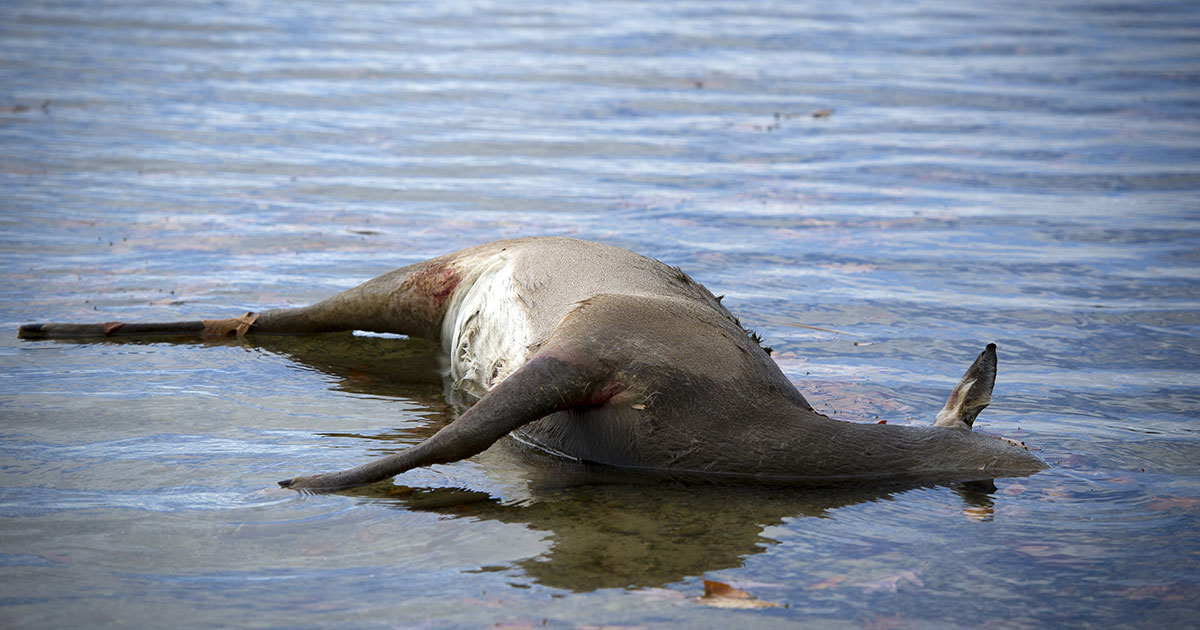- Details
By Louie Stout It’s no secret that deer are dying throughout Michiana and it’s likely to continue until we get a frost. The northern Indiana/southern Michigan die-off is the result of epizootic hemorrhagic disease, or EHD. EHD primarily affects white-tailed deer. It is transmitted through the bite of an infected midge, or biting fly. Deer cannot transmit the disease directly to one another; the virus must pass through the insect. Outbreaks of EHD typically occur in late summer and early fall but cease with the first frost, which kills the midge population. Infected deer exhibit symptoms such as loss of appetite, reduced fear of humans, weakness, excessive salivation, rapid pulse, increased respiration and fever. They may also seek out water to cool their elevated body temperatures. In severe cases, the disease leads to unconsciousness and death. Wildlife biologists in both states are monitoring the EHD outbreak but acknowledge there isn’t much they can do.  Dead Deer from EHD
Dead Deer from EHD
- Details
IDNR Report
The Natural Resources Commission gave final adoption of amendments to rule proposals governing deer hunting and river otter trapping at its meeting on Sept. 17.
The proposed deer regulation changes are listed below. The changes will not take effect this year except for the change in the definition of deer license bundle, bonus county antlerless limits, deer reduction zones, and ability to use an infrared sensor to retrieve a dead deer under an interim rule approved by the Governor’s Office and DNR Director.
Public comments can be submitted to the Natural Resources Commission (NRC) at www.IN.gov/nrc/rules/rulemaking-docket by clicking on “Submit Comments Here” in the Rulemaking Docket for the Proposed Bobcat Amendments.
Comments can also be sent by regular mail to:
Natural Resources Commission – Division of Hearings
Indiana Government Center North
100 North Senate Avenue – Room N103
Indianapolis, IN 46204
The deadline for submitting public comments is Nov. 14. The initial public hearing is on Thursday, Nov. 14, at the Southeast – Purdue Agricultural Center at 4425 East 350 North, Butlerville, IN 47223, from 5-7 p.m. ET on Nov. 14. You can attend in person or online anytime during that timeframe. The public hearing will also be webcast live on the NRC’s rulemaking docket website at www.IN.gov/nrc/rules/rulemaking-docket during the time of the public hearing, and comments will also be able to be made live through the online webcast. Sign up for updates at https://on.IN.gov/dfw-rule-changes.
- Details
IDNR Report
The Indiana DNR is reducing the County Bonus Antlerless Quotas (CBAQ) in Wabash, Porter, and Allen counties from two bonus antlerless deer to one bonus antlerless deer for the coming deer hunting season. This change is a result of the impact of epizootic hemorrhagic disease (EHD) on the deer herd in northern Indiana this year.
Changes to the CBAQ will not affect the Deer Reduction Zones.
Humans are not at risk for contracting EHD.
EHD is a viral disease that commonly affects white-tailed deer and is transmitted by biting midges, also known as sand gnats or “no-see-ums.” Cases typically occur during late summer and early fall, and there is evidence that outbreaks can be more severe in years in which there is a wet spring followed by a hot, dry fall. EHD is often fatal to deer, but some can recover and develop immunity.
Deer infected with EHD may display unusual behaviors such as lethargy, excessive salivation, or disorientation. EHD also causes fever in deer, which can cause them to seek water. As a result, many deer that die from EHD are found in or near open water sources like ponds and rivers.
Anyone who finds a deer that is showing signs of EHD or dead in water is asked to report it at on.IN.gov/sickwildlife.
DNR monitors for EHD annually; however, severe outbreaks don’t occur every year. The severity of EHD in a single year depends on a variety of factors including climate, immunity, and other ecological factors.
The effects of the deer harvest and EHD will be evaluated after the deer hunting season, and additional changes will be made for the 2025 hunting season, if necessary. EHD detections can be continually monitored at on.IN.gov/EHD.
Not every deer in an affected area will contract EHD. One sign a deer has recovered from EHD is sloughing or breaking on their hooves. DNR asks that successful hunters use the Deer After Hunt Survey to report the condition of their deer’s hooves, including both normal hooves and hooves that show evidence of sloughing or damage.
- Details
MDNR Report
With some deer seasons opening this month, the Michigan departments of Health and Human Services (MDHHS) and Natural Resources (DNR) are reminding hunters not to eat venison from deer taken within three miles of Clark’s Marsh in Oscoda Township in Iosco County.
A Do Not Eat deer advisory remains in effect due to evidence that deer within three miles of the marsh were more likely to have various per- and polyfluorinated substances (PFAS), including perfluorooctane sulfonic acid (PFOS), in their livers and muscle tissue. The finding is included in the 2021 report PFAS levels in Michigan deer from the Oscoda area, Iosco County.
In addition, a Do Not Eat advisory for all fish and aquatic or semi-aquatic wildlife taken from Clark’s Marsh remains in place. This includes fish, aquatic and semi-aquatic mammals (including muskrats), amphibians (including frogs), mollusks (including snails), reptiles (including turtles) and arthropods (including crayfish).
PFOS are associated with several negative health effects, such as liver damage, high cholesterol and reduced fertility. The advisories set in Clark’s Marsh are meant to protect the health of Michigan families.
There are three separate health advisories currently in effect for Clark’s Marsh:
- A Do Not Eat fish advisory in effect since 2012.
- A Do Not Eat deer advisory issued in 2018, updated in 2019 and again in 2021. The 2021 update shrank the five-mile advisory area to a three-mile advisory area.
- A Do Not Eat resident aquatic and semi-aquatic wildlife advisory in effect since 2019.
A map of the Do Not Eat deer advisory area shows the boundaries of the Do Not Eat deer advisory.
MDHHS continues to recommend that people do not eat organs from any fish, deer or other wild game in the state as many chemicals, including PFAS, can accumulate in the organs of wildlife.
For more information about PFAS, visit the PFAS webpage at Michigan.gov/PFASResponse.
For more information about wild game consumption, visit Michigan.gov/EatSafeGame.
- Details
MDNR Report
 Dead Michigan Deer
Dead Michigan Deer
A common viral deer disease has made a return to St. Joseph County after a three-year hiatus, with additional counties likely to follow. Over the past several weeks, the Michigan Department of Natural Resources has received reports of over 120 probable cases of epizootic hemorrhagic disease, primarily from counties in the southwestern Lower Peninsula.
The DNR Wildlife Health Section and the Michigan State University Veterinary Diagnostic Laboratory recently confirmed the EHD virus in a free-ranging white-tailed deer from St. Joseph County. Several other counties are awaiting lab confirmation.
EHD is a viral, sometimes fatal disease found in wild ruminants such as white-tailed deer, mule deer and elk.
“Although early reports indicate 2024 could see a significant outbreak of epizootic hemorrhagic disease in pockets of Michigan’s deer population, this isn’t necessarily unusual,” said Chad Stewart, acting supervisor of the DNR Wildlife Division's Sustainable Populations Section.
Stewart said that EHD-related deer deaths have occurred on and off in Michigan since 2006. During these EHD outbreaks, an estimated 50 to 1,000 deer died in isolated areas. The largest die-off occurred in 2012, with an estimated loss of more than 14,000 deer in more than 30 counties. No cases of EHD were confirmed in 2014 or 2015, and deer mortality has occurred to varying degrees annually since 2015.
There is no known effective treatment for, or control of, EHD in wild populations. The disease has been seen for decades in many areas of the United States.
EHD symptoms, pathways
EHD is transmitted by a type of biting fly called a midge of the genus Culicoides. Weather conditions in 2024 have made it easier for the virus to spread. Studies in other states have shown that a warm spring followed by a relatively rainy July and hot, dry August seem to be significant factors that make an outbreak more likely. When these conditions are present, muddy areas where this fly lays its eggs and reproduces become more common. Warm temperatures in late summer and early fall also contribute to the virus replicating more rapidly.
Outbreaks of EHD are characterized in several ways:
- Sick and dead deer are found in or around bodies of water.
- Illness in deer can come on suddenly and severely but also can linger for weeks or months in a low-grade state.
- In severe forms of the disease, deer lose their appetite and their fear of humans, grow progressively weaker, salivate excessively and finally become unconscious.
- Due to a high fever and dehydration, infected deer often seek water to lower their body temperature and to rehydrate.
Stewart said that while mortality rates can be high in some localized areas, not all deer will contract EHD, and not all deer that get EHD will die from it.
“Deer that survive epizootic hemorrhagic disease develop immunity to the virus, and outbreaks are rarely seen in the same area in consecutive years,” he said.
What should the public know?
EHD is not expected to have widespread deer population-level impacts, but it can significantly affect localized areas if mortality is severe. The onset of a hard frost will kill the “insect vector” – essentially the carrier for disease transmission – stopping movement of the virus.
In areas with significant mortality, local deer numbers tend to rebound after two to three years.
EHD is not transmitted from deer to deer. There is no evidence that humans or household pets can contract the EHD virus.
For hunters who hunt in areas that were affected by EHD, venison is still safe for consumption. While it’s not recommended you consume venison from animals that are visibly sick, if a deer is harvested during the hunting season in an area that had EHD, there is no evidence humans can contract the virus from consuming venison.
Deer carcasses can be disposed of through natural decomposition, which does not spread EHD or contribute to outbreaks. Property owners are responsible for proper disposal of carcasses if they wish to remove them. Carcasses can be buried at sufficient depth so that no body parts are showing, or they can be disposed of at landfills that accept household solid waste.
Looking ahead
The DNR expects additional EHD cases in more counties to be confirmed in the coming weeks. Deer must be tested within 24 hours of death for proper diagnostic testing, and the whole carcass is required for testing.
Once EHD has been confirmed in a county, no additional deer from that county need to be tested. Areas that have been reporting cases since early August will see the most widespread population impacts. Areas with no reported cases until mid- to late September likely will see less severe effects on local deer numbers.
“If you suspect a deer death is due to epizootic hemorrhagic disease, please report it to the DNR so that we can track cases and better estimate the total number of deer affected in an area,” Stewart said. “Hunters’ observations can be especially helpful as they hit the field and look around this fall.”
Anyone who discovers sick or dead deer near bodies of water is urged to report it using the DNR’s Eyes in the Field webpage.
Learn more about epizootic hemorrhagic disease in white-tailed deer.




